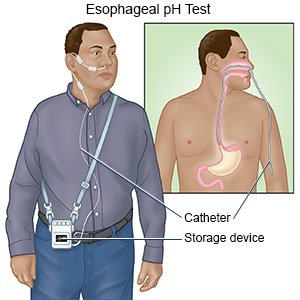Esophageal Ph Test
Medically reviewed by Drugs.com. Last updated on Apr 6, 2025.
AMBULATORY CARE:
An esophageal pH test
measures the amount of stomach acid that reaches your esophagus. This test is often used to diagnose gastroesophageal reflux disease (GERD).
How to prepare for the test:
- Stop taking antireflux medicines before your test, as directed.
- Do not eat or drink for 4 to 6 hours before your test.
What will happen during the test:
You may receive medicine to numb the area or help you relax. A catheter (small tube) will be inserted into your nose or mouth. The catheter is used to lower a probe into your esophagus. The probe may stay attached to the catheter. If so, the catheter is taped to your nose to hold it in place. Sometimes the probe is wireless, so the catheter is removed after the probe is placed.
 |
Drugs used to treat this and similar conditions
Nexium
Nexium is used to treat GERD and other conditions involving excessive stomach acid. Learn about ...
Ozempic
Learn about Ozempic (semaglutide) for type 2 diabetes treatment, weight management, cardiovascular ...
Protonix
Protonix (pantoprazole) is used to treat erosive esophagitis and other conditions involving excess ...
Prilosec
Prilosec (omeprazole) is used to treat symptoms of GERD and other conditions caused by excess ...
Phazyme
Phazyme is used for endoscopy or radiology premedication, functional gastric disorder, gas ...
Dexilant
Dexilant is used for barrett's esophagus, erosive esophagitis, GERD
Famotidine
Famotidine is used to treat and prevent ulcers in the stomach and intestines. Learn about side ...
Pantoprazole
Pantoprazole is a proton pump inhibitor used to treat GERD, erosive esophagitis, and ...
What to expect after the test:
The probe will measure your stomach acid levels while you go about your usual daily activities. The measurements are transferred to a small storage device that you wear at your waist or shoulder. You must return to have the catheter removed the next day. The wireless probe can collect data for 2 days or more. It will travel through your digestive system and come out in a bowel movement.
Call your doctor or gastroenterologist if:
- You have chest pain.
- You have questions or concerns about the test.
Keep a diary during the testing period:
- Keep your daily routine as normal as possible.
- Follow your healthcare provider's instructions on what to eat and drink. Write down everything you eat and drink, what time, and how much you consume.
- Write down the times you were lying, standing, sitting, and sleeping.
- Write down your symptoms, what time they occur, and your body position at that time.
- Give the diary to your healthcare provider. Your provider will compare it with the data collected during the test.
Follow up with your doctor or gastroenterologist as directed:
You may need to return the next day to have your catheter removed. Write down your questions so you remember to ask them during your visits.
© Copyright Merative 2025 Information is for End User's use only and may not be sold, redistributed or otherwise used for commercial purposes.
The above information is an educational aid only. It is not intended as medical advice for individual conditions or treatments. Talk to your doctor, nurse or pharmacist before following any medical regimen to see if it is safe and effective for you.
Further information
Always consult your healthcare provider to ensure the information displayed on this page applies to your personal circumstances.
